-Bookmarked.In the above speaker..
Correct?
That is division to the tweeter?/squaker?/midd?, or lower bass in a ,5 speaker?
Cheers!
That is the division between any 2 (or 3 in the illustrated case) drivers. Traditional tweeters are all almost impossible to cross low enuff.
13500/Dcc/4 > maximum XO frequency (dimensions are in inches). You got the above wrong.
If the distance is 13.5” then the max XO frequency would be at 250 Hz or less than in an ideal world. In the actual case of the illustrated MTM Dcc is 13.2”.
dave
13500/Dcc/4 > maximum XO frequency (dimensions are in inches). You got the above wrong.
If the distance is 13.5” then the max XO frequency would be at 250 Hz or less than in an ideal world. In the actual case of the illustrated MTM Dcc is 13.2”.
dave
Last edited:
Thank you. Can you explain the reasoning behind this please, and would the same calculation apply to a two way loudspeaker?View attachment 1289171
In the above speaker, take the distance between the cebtres of the 2 bass drivers = Dcc
Divided (in inches) into 13500, divide by 4 and that is the highest frequency that you can cross at. This is often compromised.
This paticular loudspeaker has a 250 Hz XO.
dave
Danley is why. At a quarterwave length teh 2 drivers essentially become coincident, to my mind, one better than a coax becasue you don’t need delay on the top.
The same formular applies to any 2 loudspeaker drivers whether woofer>mid or mid>tweeter or midBass>MidTweeter, as said earlier, very very rarely can you reach this criteria with a midBass>(typical) tweeter.
dave
The same formular applies to any 2 loudspeaker drivers whether woofer>mid or mid>tweeter or midBass>MidTweeter, as said earlier, very very rarely can you reach this criteria with a midBass>(typical) tweeter.
dave
As in most all standmounts?, as said earlier, very very rarely can you reach this criteria with a midBass>(typical) tweeter.
Most cone + dome 2-ways.
Danley’s work emerged with his Synergy the foremother of all MEHs, where he figured out a way to alighn a tweeter (compression type) with multiple midranges by using an appropriate conical horn. But those end up 3 or 4-way.
It should be noted that the example i used above, is a 2-way with the bass handling 25-250 MHz (alittle over 4 octaves) and the midTweeter .250-20k+ (the other 5+ octaves.
dave
Danley’s work emerged with his Synergy the foremother of all MEHs, where he figured out a way to alighn a tweeter (compression type) with multiple midranges by using an appropriate conical horn. But those end up 3 or 4-way.
It should be noted that the example i used above, is a 2-way with the bass handling 25-250 MHz (alittle over 4 octaves) and the midTweeter .250-20k+ (the other 5+ octaves.
dave
I think the point is, it’s just as ‘damaging’ to cross over at 2015.333hz as any other frequency.Cause in the middle of vocal range?
Cheers!
In some ways, yes, but the lower frequency can also be a better choice. For one, we are less sensitive to diffraction and response variations at those lower frequencies. Of course the crossover mistakes we make can cause power variations around the room which are difficult to fix.
Yeah, the pioneer's believed/chose equal sound power distribution, so 20-20k = (20^20000)^0.5 = ~632.456 Hz XO, Dave p10's presumed 😉 25-20 kHz = ~707.11 Hz and certainly meant easy XOs for them, me.
300hzish is an acoustic sweet spot for three way towers. With the woofer close to the floor the floor bounce is pushed above 300. With the mids close to ear level the bounce is below 300. Also many rooms Schoeder frequency is around 300 so woofers energize room nodes and mids not as much. The Schoeder frequency is a bit of a gray area.Just my opinion here, but I like to get the crossover out of the vocal band. On the low end I like crossovers around 300hz and on the high end I like them at 5,000. The 300hz crossover gets the bass out of the vocals and lowers distortion and allows you to put more power into the midrange frequencies. 200-300hz is great crossover range for a WAW.
The high crossover of 5,000hz reduces distortion in the tweeter which now does what a tweeter is supposed to do, tweet. 1” Tweeters aren’t midranges. Also, this high crossover requires a midrange that doesn’t beam at 3-5,000hz. They are hard to find so I use so called ‘full ranges’. Now having said that, I’m not the best crossover designer guy, I have limited success making the very popular 6 1/2” woofer to a 1” dome tweeter crossed at 2,500hz type of loudspeaker. I might try again with a waveguide on the tweeter.
I have a not so economical econowave system that is great through the crossover at 1,500hz. So, I’m not sure that frequency matters as much as time/phase, and even power response.
I’m interested to hear what others think.
scholl, depends on listening distance. For example both ear and transducer at 90cm (3') height from floor, the floor bounce has only 50cm (~2') longer path length than direct sound when listening distance is 3m (10'). This means dip about ~350Hz. If transducer is closer to floor, or listening distance further out, the path length difference reduces and first interference dip gets even higher. So, yeah your logic sound but numbers need more context and work with some particular listening distance and drift off if listening distance changes.
Floor bounce is a myth in that sense that it is usually the shortest early reflection making anomalies highest in frequency of all six first early reflections in cubicle room. So, if there is suckout on low mids, it's not likely floor bounce but anything else, exactly opposite to what I commonly see on forums.
Any other early reflection easily falls around 300Hz or below, while floor bounce is likely bit higher. Reflection from ceiling could be octave or two lower for example.
Nevertheless, none of these come alone but early reflections in domestic rooms pile up somewhere mids, for example around 300Hz or so making wide huge dip there. Positioning of speakers is crucial in this sense, and optimizing driver height could help, as long as one takes account listening distance and all early reflections, not just the floor.
Few attachments, you can play with it here if you wish 🙂 https://audioexperiment.com/tools/vertical-reflections/
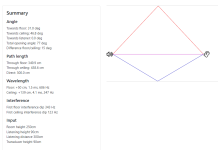
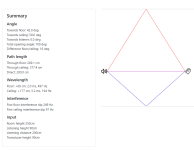
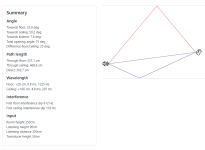
VituixCAD shows this stuff also, on the room tab, more parameters to play and wonder with:
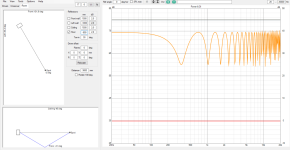
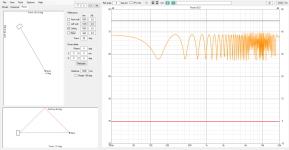
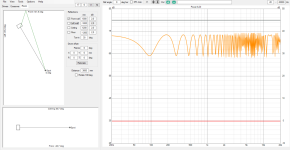
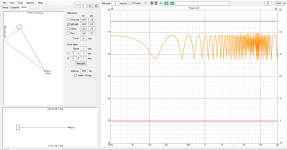
here four of the six enabled, and if I take the floor bounce out almost nothing changes. Singular early reflection is only 1 out of multiple.
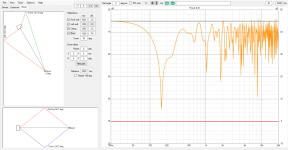
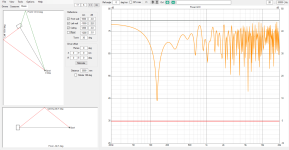
Floor bounce is a myth in that sense that it is usually the shortest early reflection making anomalies highest in frequency of all six first early reflections in cubicle room. So, if there is suckout on low mids, it's not likely floor bounce but anything else, exactly opposite to what I commonly see on forums.
Any other early reflection easily falls around 300Hz or below, while floor bounce is likely bit higher. Reflection from ceiling could be octave or two lower for example.
Nevertheless, none of these come alone but early reflections in domestic rooms pile up somewhere mids, for example around 300Hz or so making wide huge dip there. Positioning of speakers is crucial in this sense, and optimizing driver height could help, as long as one takes account listening distance and all early reflections, not just the floor.
Few attachments, you can play with it here if you wish 🙂 https://audioexperiment.com/tools/vertical-reflections/



VituixCAD shows this stuff also, on the room tab, more parameters to play and wonder with:




here four of the six enabled, and if I take the floor bounce out almost nothing changes. Singular early reflection is only 1 out of multiple.


Last edited:
I think what GM meant here is the geometric mean of 20 and 20000 i.e. (20 * 20000)^0.5 = 632.456Hz.equal sound power distribution, so 20-20k = (20^20000)^0.5 = ~632.456 Hz
I guess its a way to optimize spl from available drivers. So not related to sound quality.
Cheers!
Cheers!
@newvirus2008
True, but meant what I said 😉 based on Chapter 7 + a bit more I've posted in the past, though can't find ATM.

True, but meant what I said 😉 based on Chapter 7 + a bit more I've posted in the past, though can't find ATM.


Yes that too. Beaming and such. -So much to consider 😊. What I mean is that it can(often) be used as a rough guideline to quickly choose drivers that lives up to what is demanded from a customer. For optimal SQ many more factors needs to be considered which will move crossover frequencies up or down. My post was a too rough generallisation too😊.
Cheers!
Cheers!
- Home
- Loudspeakers
- Multi-Way
- What would be the least damaging x-over frequency